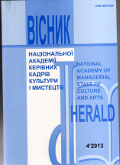Genre-style spectrum of bayan-ensemble literature in Ukraine
DOI:
https://doi.org/10.32461/2226-3209.4.2013.138040Keywords:
bayan-ensemble acting, genre-style spectrum, repertoireAbstract
The article is dedicated to the research of one of the most important aspects of national bayan-ensemble acting – its repertoire supplying. Therefore, the object of the research is the relevant stratum of musical works, and the subject is represented by its genre-style spectrum, additionally, the objective of the research is the classification of its main genre and stylistic groups. The scientific novelty in this context is contributed by ordering and specification of existing data in terms of genre-style definitions and the chronology of development of the bayan-ensemble literature. The analysis of musicological and repertoire literature allowed the author of this article to specify periods of folk movement in concert-performing and composer practice. The first period is dated from the end of XIX century to the first decades of the XX century. The quest for storing of the original genre-style image has allowed scientists to determine this period in the specified repertoire field as purely "folkloristic" (or "folk"). The second period is dated by 1940-1960s and it is defined as the period of academicism ("folk-academic" period). The next (third) period (since 1970 till 1980s) is associated with the general neofolk trend in music, which is defined as a phase of "new folk wave ". The modern period has begun since the last decade of XX century to the present day and it is a period that can be called as a kind of "metaneofolklorism". Throughout the process of professionalization and academicism of bayan-ensemble repertoire, the special attention deserves its component such as translation. This particular stratum of repertoire (translated literature) has become the impetus for the formation of such stylistic trends in the bayan art as the neoclassicism and neobaroque.Downloads
Published
Issue
Section
License
Authors who publish with this journal agree to the following terms:
1. Authors retain copyright and grant the journal right of first publication with the work simultaneously licensed under a Creative Commons Attribution License International CC-BY that allows others to share the work with an acknowledgement of the work's authorship and initial publication in this journal.
2. Authors are able to enter into separate, additional contractual arrangements for the non-exclusive distribution of the journal's published version of the work (e.g., post it to an institutional repository or publish it in a book), with an acknowledgement of its initial publication in this journal.
3. Authors are permitted and encouraged to post their work online (e.g., in institutional repositories or on their website) prior to and during the submission process, as it can lead to productive exchanges, as well as earlier and greater citation of published work (See The Effect of Open Access).


